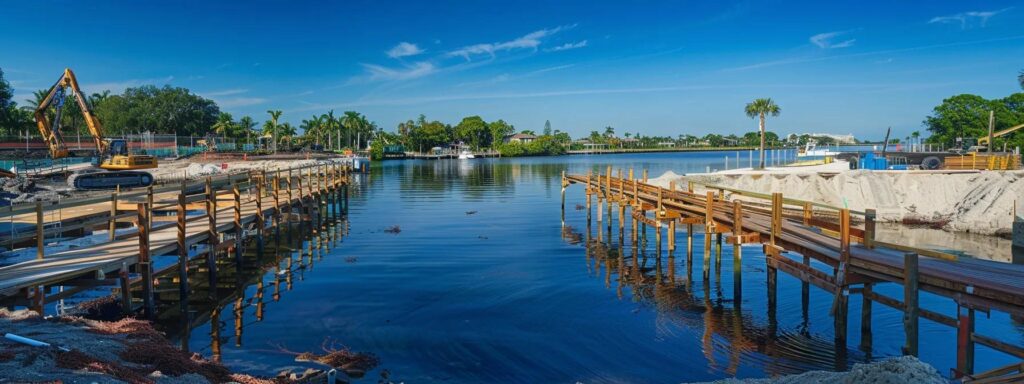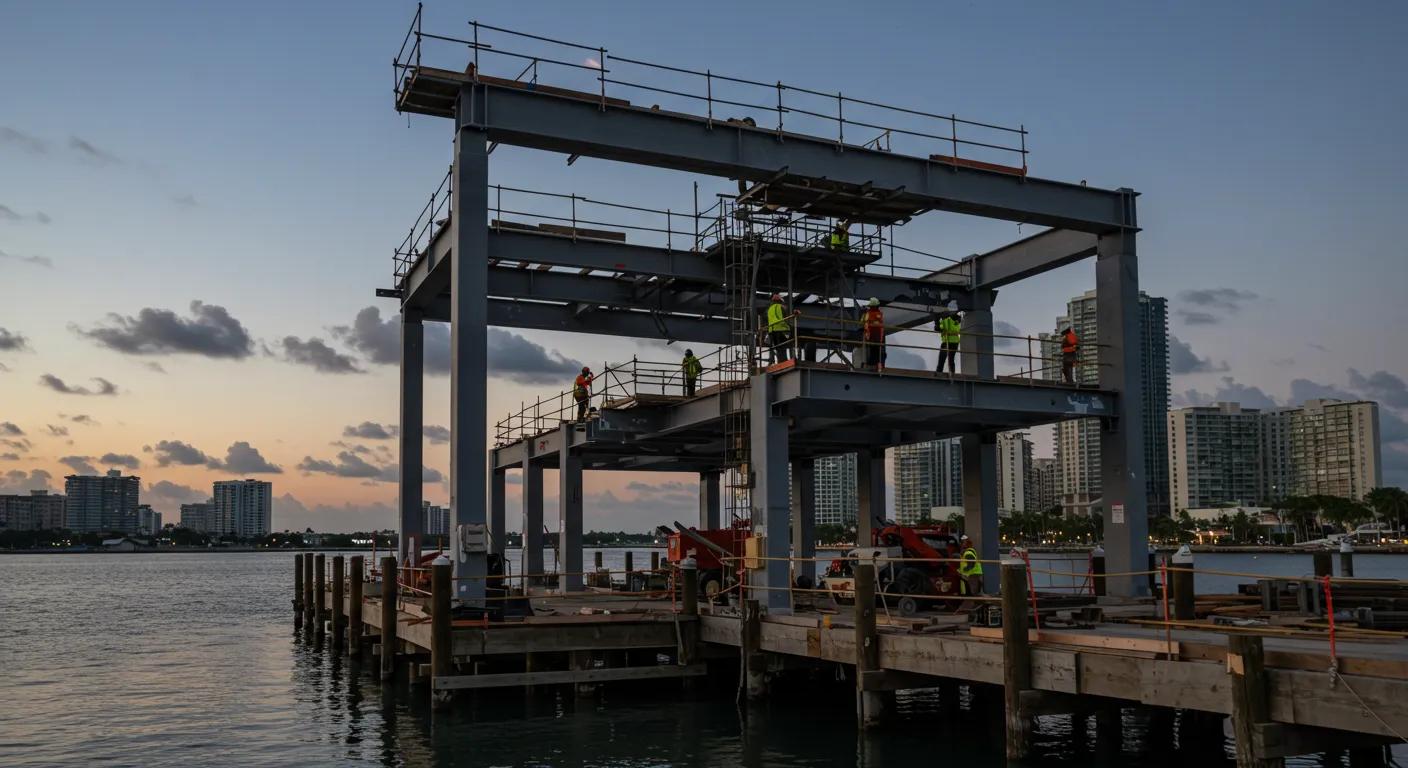Essential Strategies for Keeping Your Dock Construction Project on Budget and on Time
The success of your dock construction project depends not only on solid craftsmanship and quality materials but also on effective budget management and financial planning. From setting clear financial goals and defining the project scope to managing unforeseen costs and contractor payments, these strategies are designed to keep your construction project within budget and on schedule. By establishing realistic financial objectives, reviewing contractor quotes, and implementing cost-saving measures, you can navigate the complexities of dock construction confidently. This guide will help you break down costs, monitor progress with regular financial updates, and communicate effectively with stakeholders. With decades of experience and quality installations by All American Installers, our methods address everything from resource procurement and labor costs to risk management and regulatory compliance. Let’s explore these strategies so you can achieve project efficiency, transparency, and protect your profit margins while maintaining high dock quality.
Understand Your Project Budget and Define Financial Goals
Begin by clearly defining your financial goals. Outline what you expect from your dock construction project in terms of deliverables, scheduling, and resource allocation. Setting specific financial targets improves risk management and accountability to stakeholders.
Break Down Costs for Materials and Labor With Precision
Detail all expenses related to materials, labor, and other costs. Itemize products like concrete, steel reinforcements, wood treatments, and subcontracted resources. An accurate cost breakdown prevents underestimations and ensures precision in allocating resources. For example, calculating the required concrete in tons and wood finishes by square footage helps align costs with production timelines and improves procurement and scheduling.
Assess Contingency Funds for Unexpected Expenses
Reserve contingency funds to cover unforeseen issues such as supply delays, design modifications, or labor shortages. Typically, successful projects reserve 10% to 20% of the total budget to manage risks without sacrificing project quality. This approach promotes risk minimization and emphasizes transparency with contractors regarding potential budget adjustments.
Create a Detailed Payment Schedule for Contractors
A clear payment schedule is crucial to maintaining cash flow and ensuring timely delivery. Negotiate milestones and payment releases based on verifiable deliverables. This structured schedule motivates contractors to meet deadlines while allowing you to manage funds effectively and track progress, thereby reducing the risk of cost overruns.
Choose Reliable Dock Construction Professionals Wisely

Selecting the right professionals is essential for keeping your project on time and within budget. Reliable contractors bring technical expertise, accurate estimates, effective risk management, and consistent quality standards, thereby reducing delays and cost escalations.
Research Contractor Credentials and Past Projects Effectively
Thoroughly research potential contractors before hiring. Review credentials, certifications, and completed project records to ensure they meet your quality expectations and understand regulatory requirements and environmental considerations. This diligence boosts confidence and minimizes the risk of unforeseen liabilities.
Solicit Multiple Quotes to Compare Services and Rates
Obtain multiple quotes to ensure competitive pricing without compromising quality. Compare bids by evaluating the scope of work, materials used, labor rates, and timelines. A comprehensive comparison helps you select a contractor who balances cost-effectiveness with quality, safeguarding against price inflation and substandard services.
Check References and Read Online Reviews Thoroughly
Verify references and read online reviews to gauge a contractor’s reputation. Feedback from past clients regarding work quality, punctuality, and communication can reveal potential red flags. This step is vital in avoiding projects characterized by scope creep and inefficiencies.
Monitor Progress With Regular Financial Updates
Keep a vigilant eye on your dock construction project’s finances. Regular updates offer insights into current spending and help detect variances from the original budget. Scheduled reviews allow you to catch potential overruns early and adjust plans before minor issues escalate.
Schedule Timely Meetings to Review Financial Status
Hold routine financial review meetings with your construction team and stakeholders. These sessions provide opportunities to discuss current expenditures, compare progress against the planned budget, and adjust strategies as necessary. Regular, scheduled meetings promote transparency and proactive problem-solving.
Adjust Budgets Based on Project Phase and Realities
As the project advances, adjust budgets to reflect changing circumstances. By aligning budget reviews with different project phases, you can reallocate funds where needed—whether for extra labor during peak periods or fluctuating material costs. This proactive approach helps mitigate risks and control financial commitments.
Utilize Project Management Software to Track Finances
Use project management software to integrate financial data with construction schedules. Real-time expense tracking through digital dashboards and interactive reports enables informed decisions. Such tools also help synchronize communications among all parties regarding budget adjustments and overall project scope.
Implement Cost-Saving Strategies During Construction

Cost-saving strategies help you stay within budget without sacrificing quality. Efficiency, sustainable material choices, and streamlined processes all contribute to long-term savings and prevent budget overruns.
Opt for Sustainable Materials That Lower Long-Term Costs
Choosing sustainable, eco-friendly materials can lower maintenance and replacement costs over time. Although these materials may have higher initial costs, their durability and energy efficiency lead to significant long-term savings. Additionally, sustainable choices may qualify for regulatory incentives and rebates.
Streamline Construction Processes to Minimize Delays
Improve workflow efficiency by implementing lean construction methods such as just-in-time delivery and effective labor deployment. Standardized procedures, clear communication protocols, and contingency planning reduce delays and prevent unnecessary expenses. This creates a smoother progress schedule and maintains budget adherence.
Consider Affordable Alternatives Without Sacrificing Quality
Evaluate multiple suppliers and explore cost-effective alternatives that meet required safety and quality standards. Locally sourced materials may reduce transportation costs and lead to faster delivery. Negotiating favorable terms or bulk discounts with subcontractors can yield substantial savings while preserving quality and durability.
Communicate Effectively With All Stakeholders Involved
Effective communication underpins every successful dock construction project. Whether coordinating with contractors, architects, or clients, clear, consistent dialogue ensures everyone is aware of budget changes, schedule adjustments, and emerging issues. This minimizes misunderstandings and prevents project delays.
Maintain Transparency With Clients About Financial Matters
Openly share all financial aspects with clients. Providing regular budget updates and detailed expense breakdowns builds trust and keeps clients informed of any scope changes or extra costs. Clear communication reinforces professionalism and helps prevent disputes.
Update Team Members on Budget Changes Regularly
Keep your entire team informed of budget fluctuations through regular meetings, email updates, or shared digital dashboards. Continuous communication helps ensure that all departments work collaboratively to adjust to financial challenges and avoid misallocations.
Establish Clear Channels for Ongoing Discussions
Set up dedicated communication channels for budget and project updates. Centralized platforms—such as scheduled conference calls, email newsletters, or integrated project management tools—ensure that questions are answered promptly and feedback is efficiently managed. Clear channels reinforce an organized workflow and help quickly address financial concerns.
Evaluate Financial Performance Post-Project Completion

After project completion, evaluating the financial performance is key to identifying lessons learned and planning future budgets. Compare actual expenditures against initial estimates to understand what contributed to any variances and determine strategies for future improvements.
Analyze Expenses Against Initial Budget for Insights
Conduct a detailed analysis by examining costs in categories such as materials, labor, and administrative expenses. Understanding whether costs were accurately forecasted helps identify discrepancies and improves future budgeting efforts.
Document Lessons Learned for Future Dock Projects
Compile a report detailing successes and challenges encountered during the project. Documenting instances of budget overruns or inefficiencies helps refine strategies and builds a repository of best practices for future dock construction projects.
Prepare a Comprehensive Financial Report for Stakeholders
Create a detailed report that includes tables, graphs, and narratives outlining expenses, deviations from the budget, and overall financial performance. Transparent reporting reinforces fiscal responsibility and provides stakeholders with clear insights into how funds were allocated and managed.
Detailed List of Cost-Saving Strategies
- Sustainable Materials – Long-Term Savings Choosing eco-friendly materials like recycled composites and treated wood can reduce maintenance costs while meeting regulatory compliance. Their durability and energy efficiency contribute to significant long-term savings.
- Lean Construction Processes – Efficiency Improvement Implementing lean processes such as just-in-time delivery and streamlined labor deployment minimizes delays and waste, thereby improving workflow efficiency and ensuring timely project completion.
- Negotiated Supplier Contracts – Cost Reduction Negotiating favorable terms with local suppliers can secure competitive pricing and timely deliveries. Bulk purchase discounts and long-term agreements help lock in lower rates and reduce cost fluctuations.
- Digital Project Management Tools – Enhanced Monitoring Using advanced project management software allows for real-time tracking of financial performance and scheduling, enabling precise adjustments and clear stakeholder communication.
- Alternative Financing Options – Budget Flexibility Exploring cost-effective financing options like loans or rebates for sustainable practices offers additional resources during unplanned expenditures.
Table: Comparison of Financial Strategies in Dock Construction
Below is a table summarizing key cost-saving strategies along with their benefits and attributes:
| Strategy | Key Benefit | Attribute | Impact |
|---|---|---|---|
| Sustainable Materials | Lower long-term maintenance costs | Durability, eco-friendly | 15-20% reduction in upkeep costs |
| Lean Construction Processes | Increased efficiency | Streamlined workflow | Decrease delays by 10-15% |
| Negotiated Supplier Contracts | Reduced material costs | Bulk discounts | Save 5-10% on material costs |
| Digital Project Management Tools | Real-time financial tracking | Transparency, precision | Enhanced budget control |
| Alternative Financing Options | Improved budget flexibility | Competitive rates | Access to extra funds |
This table offers a snapshot of how each strategy contributes to overall cost management and financial efficiency, creating a robust framework for successful project delivery.
Frequently Asked Questions
Q: How can I accurately break down the costs for my dock construction project? A: Itemize every expense including materials, labor, equipment rentals, and permits. Create separate categories for major items such as concrete, wood finishes, and subcontractor fees, and allocate precise amounts based on supplier quotes and historical data.
Q: What methods can I use to track financial progress during construction? A: Use project management software that integrates budget tracking with scheduling. Regular meetings, digital dashboards, and detailed reports provide real-time assessments of expenditures against planned budgets, ensuring transparency and timely interventions.
Q: Why is it important to reserve contingency funds for dock construction projects? A: Contingency funds protect against unexpected expense fluctuations such as delays, material price increases, or extra labor costs. Reserving 10-20% of the total budget minimizes risk and prevents financial strain.
Q: How does effective communication with contractors impact project budgeting? A: Regular, clear communication ensures everyone is aligned with project goals and financial parameters. Sharing budget updates and resolving discrepancies promptly helps prevent misunderstandings and encourages timely, efficient work.
Q: What benefits do sustainable materials provide in dock construction? A: Although they may have higher initial costs, sustainable materials offer long-term savings through reduced maintenance, improved durability, corrosion protection, and potential energy rebates.
Q: How can negotiating supplier contracts contribute to staying on budget? A: Negotiating can secure bulk discounts and stable pricing, reducing material costs and minimizing unforeseen expenses. This proactive approach helps maintain budget constraints throughout the construction stages.
Q: What role does digital project management play in dock construction budgeting? A: Digital tools provide real-time insights into budget performance, schedule adherence, and risks. They enable prompt adjustments and ensure every stakeholder remains informed, which is critical for maintaining project scope and efficiency.
Final Thoughts
Effective budget management for dock construction involves strategic planning, continuous financial monitoring, and clear stakeholder communication. By breaking down costs, reserving contingencies, and choosing reliable professionals, you reduce risks and enhance project success. The use of sustainable materials and digital tracking further improves cost-efficiency and transparency. Adopting these strategies will ensure that your dock construction project remains on budget, on schedule, and delivers long-term value.




